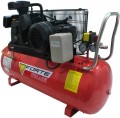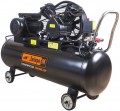Input performance
The amount of air that the compressor is able to process per unit of time; usually stated in liters per minute. Performance, along with pressure (see below), is one of the most important parameters: it is it that primarily determines how compatible the compressor will be with one or another pneumatic tool.
It is worth choosing a model according to this indicator in such a way that it can be guaranteed to “pull out” all the tools that can be connected at the same time. Air consumption is usually directly indicated in the characteristics of each tool, and it is quite simple to calculate the total requirement. However, due to the design features, the compressor must have a certain performance margin; the specific value of this stock depends on a number of nuances.
The main point is that some companies indicate for their units the performance at the outlet (how much air is supplied to the tool), while others indicate at the inlet (how much air the compressor sucks in). Since no compressor is perfect, part of the air is inevitably lost during the compression process, so the amount of air at the outlet will always be less than at the inlet. Accordingly, if the output performance is indicated in the characteristics, a margin of 10-20% is recommended, and if the input is 35-40%.
There are also more complex techniques that allow you to more accurately derive the required performance depending on the characteristics of specific tools; they can be found in...special sources.
Rated pressure
The maximum pressure created by the compressor during operation. This parameter, as well as the performance described above, is very important for selecting a compressor for a specific pneumatic tool: it is necessary that the nominal pressure be not lower than the working pressure of the tool. At the same time, high pressure is not a problem — it can be reduced by the appropriate regulator on the gearbox.
Most modern compressors have a
pressure rating of 8 bar, which is sufficient for most air tools. Units for 6 bar belong to the entry level, their main purpose is painting work, where high pressure is not required. There are also options for 10 bar and even more — they, usually, belong to specialized models and cost accordingly. Therefore, it is worth looking specifically for a high-pressure unit only if this parameter is critical for the planned work (for example, if you need a compressor for tyre fitting).
When selecting according to the nominal pressure, it must be taken into account that the maximum allowable pressure in the receiver is usually indicated as the nominal pressure. The pressure actually given out by the compressor to the outlet is often somewhat less, this is due to some design features. For the most popular nominal pressure options — 8 and 10 bar — the real figures are usually 2 bar less, i.e. 6 and 8 bar respectively.
Power
The power of the engine installed in the compressor. It is not the main parameter in evaluating the efficiency of the device — here the performance and nominal pressure play a decisive role (see above), and the engine is selected in such a way that its power is sufficient to ensure the claimed characteristics. However, this indicator still has practical significance: in compressors with an electric motor (and there are now most of them; see “Engine type”), the engine power determines the total energy consumption of the device, as well as the requirements for the network where it is planned to connect it (for more details, see “Voltage networks"). In addition, the power of the engine (regardless of its type) must be known in order to calculate the optimal performance value using some special formulas.
For internal combustion engines, power is traditionally expressed in horsepower (hp); you can convert it to watts in this way: 1 hp. = 735 W.
Number of cylinders
The number of cylinders provided for in the design of the compressor; by definition only indicated for reciprocating models (see "Compressor type"). This characteristic is primarily associated with performance indicators (see above). For example, values above 400 L / min among
single-cylinder units are rather rare exceptions; therefore, if you need a high performance reciprocating compressor, you should look into multi-cylinder models. The second application for multiple cylinders is a multi-stage operation scheme (see "Number of stages").
Power source
Among the power sources in compressors are
the electrical network,
batteries,
gasoline and
diesel. A different section is provided for classic automobile compressors, but there are also reputable
compressors powered by 12 V. More details about each of them:
—
Electrical network (230 V). The most popular power source used in modern compressors. Electric motors have relatively small dimensions and weight, and during operation they create significantly less noise than internal combustion engines and do not produce exhaust gases, making them safe even with poor ventilation in the room. In addition, they are easy to operate and do not require refueling, expensive starting equipment or complex procedures. The only significant drawback worth noting is the need for an external power source - if it is impossible to connect electricity, a compressor with an electric motor will be absolutely useless. Power supply from a 230 V network with single-phase alternating current limits the models in terms of power and such devices can be classified as household rather than professional.
—
Electrical network (400 V). Powered by a three-phase (three pairs of contacts “zero” – “phase”) network with a voltage of 400 V. Such a network can be conditi
...onally called “industrial”: it is not used in everyday life, but is widespread in industrial premises such as workshops, workshops, car repair bays and so on. The main advantage of this type of power supply is high power, which allows you to create compressors with high pressure and performance. At the same time, there is no point in producing low-power units for only 3 phases - the main advantage is lost, and the disadvantage of incompatibility with 230 V networks (and, accordingly, a limited scope of application) remains. Therefore, 400 V power supply is exclusively the prerogative of high-power compressors intended for professional use. Before purchasing such a device, you must make sure that there is a three-phase connection at the location of the planned installation.
— Battery. Powered by its own battery. The main advantages of this option are mobility, the ability to work independently of outlets and the absence of a power cord that can interfere with work. On the other hand, such power supply is not suitable for high power; all other things being equal, a cordless tool turns out to be noticeably heavier and more expensive than a mains one, and the operating time is limited by the battery charge. However, in most cases the battery is removable, which allows you to keep several batteries ready and change them as needed.
- Gasoline. An internal combustion engine (ICE) using gasoline as fuel. Such compressors are indispensable if you have to work in places without access to electricity: gasoline engines do not depend on external power sources, are completely autonomous and can operate as long as there is fuel in the tank. On the other hand, they are more expensive than electric ones (both on their own and in operation, due to the high cost of gasoline), weigh more, make more noise, are difficult to start and require certain maintenance skills. In addition, exhaust gases create serious inconvenience and limit the use of internal combustion engines - when working indoors, good ventilation is necessary. As a result of all this, compressors with gasoline engines are more of a backup option in case it is impossible to use an electric motor, and they are not widely used.
— Diesel. An internal combustion engine running on diesel fuel. It is characterized by all the same basic features as the gasoline one (see above), but there are some differences. The most striking thing is that diesel engines are generally more expensive than gasoline engines, but they have a longer service life and are cheaper to operate due to the relatively low price of fuel.
— Electrical network 12 V. The compressor can be connected to the vehicle network as power supply.
